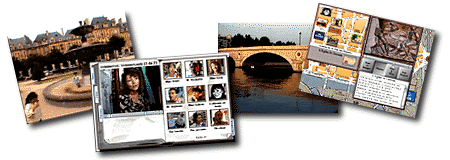|
Objective
Subject
It is a visual database, which includes people, streets, buildings, objects and artifacts that can be explored in multiple ways by learners at many different levels, and for many different purposes.
Context
to have access to the issues that have shaped the neighborhood, such as gentrification and the role of City Hall; and to hear of the changes that have taken place in the neighborhood over the last decade.
M. Desmarty explains why the neighborhood was better before...
Delivery
The Map allows the user to randomly explore the neighborhood. The Guide provides the user with more structured information. It contains four entries:
1) Gens, which lists all the people one can meet
2) Lieux, which lists all the places one can visit.
3) Paroles, which focuses on the words that people use when they talk about
certain aspects of their neighborhood: what a "real commercant" is, what
"lively" means, what "habiter" means, etc... The juxtaposition of several
points of view around a same word allows the user to uncover the different
meanings these words hold for different people. 4) Perspectives, which focuses on the references people make when they talk about their neighborhood (notions of time, of space, of self, of others, etc...), provides learners with clues to how people frame issues, and allows themto acess the underlying cultural framework within which people express and define themselves vis a vis their environment. |
|


Dans un quartier de Paris
Sponsors
Direct all inquires to
Availability
Audience Dans un quartier de Paris is not a self-instructional program. But it lends itself to the design of a multiplicity of culturally-based tasks to be done by language learners of all levels, both in the language lab and the classroom. A Teacher's manual and a Student activities workbook will accompany the program when it comes out.
Format
Other features 1) a museum which will give access to a large number of historical texts and images, designed to allow the user to view the quartier within its larger historical framework, its own life continuum and from within its own cultural markers and references, thus providing users with a broader and more in-depth view of a foreign cultural world. 2) a visual notebook that will make it possible for users to be transformed into reporters, researchers, photographers, videographers, guides or witnesses, and record their experience in a multimedia format, with words, images, and/or video segments. Such a tool will greatly expand the learner's role from that of a consurmer of images and texts to one who is actively and critically interacting with materials. |
|||||||||||||||||
 |

|
![]()
![]()









